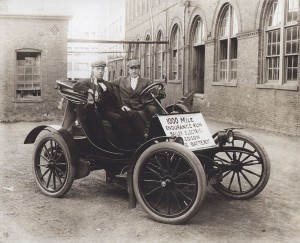A nickel-iron battery designed to be recharged 100 years ago by Thomas Edison for use in electric vehicles has been revived with the addition of graphene. From the June 26, 2012 news item by Mark Schwartz on EurekAlert,
Designed in the early 1900s to power electric vehicles, the Edison battery largely went out of favor in the mid-1970s. Today only a handful of companies manufacture nickel-iron batteries, primarily to store surplus electricity from solar panels and wind turbines.
“The Edison battery is very durable, but it has a number of drawbacks,” said Hongjie Dai, a professor of chemistry at Stanford. “A typical battery can take hours to charge, and the rate of discharge is also very slow.”
Now, Dai and his Stanford colleagues have dramatically improved the performance of this century-old technology. The Stanford team has created an ultrafast nickel-iron battery that can be fully charged in about 2 minutes and discharged in less than 30 seconds. The results are published in the June 26 [2012] issue of the journal Nature Communications.
Here’s how the battery worked originally and what they’ve done to improve it,
Edison, an early advocate of all-electric vehicles, began marketing the nickel-iron battery around 1900. It was used in electric cars until about 1920. The battery’s long life and reliability made it a popular backup power source for railroads, mines and other industries until the mid-20th century.
Edison created the nickel-iron battery as an inexpensive alternative to corrosive lead-acid batteries. Its basic design consists of two electrodes – a cathode made of nickel and an anode made of iron – bathed in an alkaline solution. “Importantly, both nickel and iron are abundant elements on Earth and relatively nontoxic,” Dai noted.
Carbon has long been used to enhance electrical conductivity in electrodes. To improve the Edison battery’s performance, the Stanford team used graphene – nanosized sheets of carbon that are only one-atom thick – and multi-walled carbon nanotubes, each consisting of about 10 concentric graphene sheets rolled together.
“In conventional electrodes, people randomly mix iron and nickel materials with conductive carbon,” Wang explained. “Instead, we grew nanocrystals of iron oxide onto graphene, and nanocrystals of nickel hydroxide onto carbon nanotubes.”
This technique produced strong chemical bonding between the metal particles and the carbon nanomaterials, which had a dramatic effect on performance. “Coupling the nickel and iron particles to the carbon substrate allows electrical charges to move quickly between the electrodes and the outside circuit,” Dai said. “The result is an ultrafast version of the nickel-iron battery that’s capable of charging and discharging in seconds.”
The Stanford researchers created a 1-volt ‘graphene-enhanced’ nickel-iron prototype battery for experimentation in the lab. This battery can power a flashlight but the researchers are hoping to scale up so that the battery could be used for the electrical grid or transportation.
The lead author for the study is Hailiang Wang, a Stanford graduate student. Other co-authors of the study are postdoctoral scholars Yongye Liang and Yanguang Li, graduate student Ming Gong, and undergraduates Wesley Chang and Tyler Mefford also of Stanford; Jigang Zhou, Jian Wang and Tom Regier of Canadian Light Source, Inc.; and Fei Wei of Tsinghua University.
ETA: June 27, 2012: Here, by the way, is an electric vehicle powered by Edison’s battery circa 1910, downloaded from the Stanford University site (http://news.stanford.edu/news/2012/june/ultrafast-edison-battery-062612.html) and courtesy of the US National Park Service.
